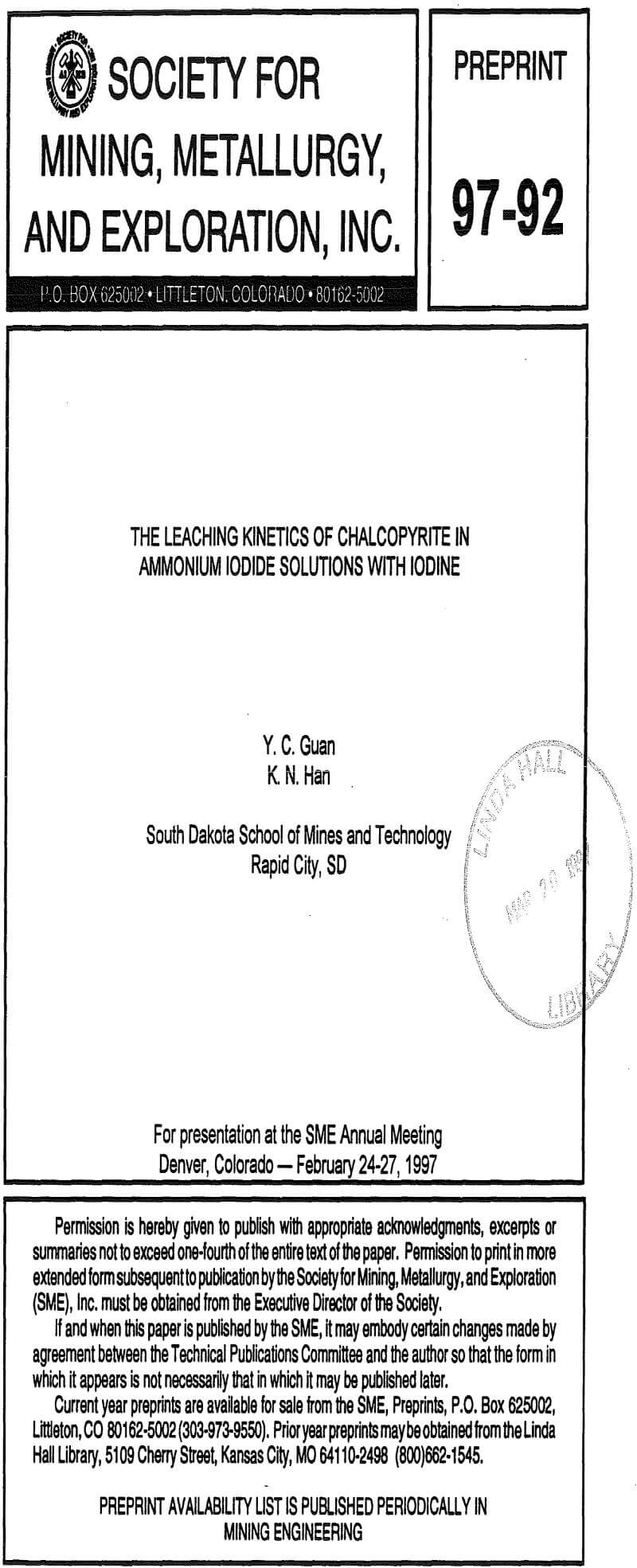Chalcopyrite is the most abundant mineral of copper sulfide minerals and the major source of copper. Numerous leaching processes, such as ammoniacal systems, acid sulfate systems, chloride systems, and nitrate systems, have been introduced and investigated. In oxygenated ammoniacal solutions, chalcopyrite dissolves according to the following reaction:
CuFeS2 + 4NH3 + 17/4 O2 + 2OH- = Cu(NH3)4²+ + ½Fe2O3 + 2SO4²-……………………………(1)
Commercial scale ammonia leaching of copper sulfide concentrates has been accomplished. The Arbitter process (Kuhn et al., 1974) is carried out at 60 to 90 °C with an oxygen pressure of 5 to 40 psig. Intensive mixing is employed to improve the rate of oxygen transfer from the gas phase to the liquid phase, and to prevent the formation of a protective hematite surface layer.
Warren and Wadsworth (1984) studied the anodic dissolution of chalcopyrite in ammoniacal solutions. They found out that at low overpotentials a deficient layer of Cu1-xFeS2 was formed. At higher overpotentials, the anodic dissolution of chalcopyrite can be described as:
CuFeS2 + 4NH3 + 9OH- = Cu(NH3)4²+ + Fe(OH)3 + S2O3²- + 3H2O + 9e……………………..(2)
Iodine has already been established as an effective oxidant for the dissolution of gold (Hiskey and Atluri, 1988; Davis and Tran, 1991). In the excess of I-, iodine will react with I- and form 1 triiodide, I3-. The triiodide ion can serve as an oxidant for dissolution of chalcopyrite according to the following electrochemical reaction:
9/2I3- + 9 e = 27/2I-…………………………………………………………………..(3)
The overall reaction for leaching of chalcopyrite in ammoniacal solutions with iodine as an oxidant can be obtained by adding Reactions 2 and 3:
CuFeS2 + 4NH3 + 9OH- + 9/2I3- = Cu(NH3)4²+ + Fe(OH)3 + S2O3²- + 3H2O + 27/2I-…………..(4)
The standard free energy change for Reaction 4 was calculated and found to be -1086.25 kJ/mole. The large negative standard free energy change indicates that chalcopyrite should readily be attacked by ammonia in the presence of triiodide, and the reaction can be assumed irreversible.
The purpose of this study was to search alternative oxidants for the ammonia leaching of chalcopyrite. Iodine was selected for this study because it has been demonstrated to be an effective oxidant for leaching of gold and other precious metals, it has a number of advantages, such as its moderate oxidation potential, higher solubility in the presence of iodide, and easy regeneration for recycling use in the system. The parameters investigated were: total ammonia concentration, iodine concentration, pH of the solution, disc rotating speed, reaction temperature, and the reaction product layer.
The chalcopyrite used in this investigation was obtained from Ward’s Earth Science. Sample disc was prepared by cutting a column bar from a large chalcopyrite specimen. The dimension of the column bar was 1.7 cm in diameter and 1.3 cm in thickness. The sample was of high quality with little impurities as evidenced by microscopic examination, X-ray diffraction, and chemical analysis. The column bar chalcopyrite was mounted in a Teflon holder with the aid of Epoxy resin. The surface exposed to leaching solution was kept constant at 2.27 cm². The sample disc was wet polished with 240 and 600 grit Carbimet paper discs before each experiment, unless for repeating experiments.
Batch leaching experiments were carried out in a 1000-ml Pyrex vessel using the 1.7 in diameter column bar chalcopyrite. Leaching solutions were prepared by dissolving a known amounts of analytical grade chemicals. The pH of the solution was adjusted by changing the ratio of NH3 to NH4+ but keeping the total ammonia concentration constant at 0.5 M. A 500 ml test solution was placed in the vessel which was then purged for one half hour with nitrogen. Reaction temperature was controlled by using a water bath. As soon as the polished sample disc was put into the leaching solution, the leaching experiment began. Nitrogen was purged for another one half hour after the experiment began, then the vessel was properly sealed to protect from evaporation of ammonia and iodide species. Solution samples were withdrawn at regular time intervals for chemical analysis. All chemical analysis were performed using a Perkin Elmer Atomic Absorption Spectrometer, Model 5500.
Unless otherwise stated, the general experimental conditions were as follows: temperature, 298 °K; ammonium iodide, 0.25 M; ammonium hydroxide, 0.25 M; iodine, 0.005 M; disc rotating speed, 450 rpm; pH 9.80.
